Go to next segment
In the translation editor, you can jump to specific segments. You can either choose detailed conditions for the segments you want to jump to, or you can jump to a segment by typing its number.
After you choose the conditions, you can repeat the same jump by pressing Ctrl+G.
How to get here
- Open a project.
- Open a document for translation.
- Press Ctrl+Shift+G.
Or: On the Edit ribbon, click the arrow next to Go To Next. From the menu, choose Settings.
The Go to next segment window opens.
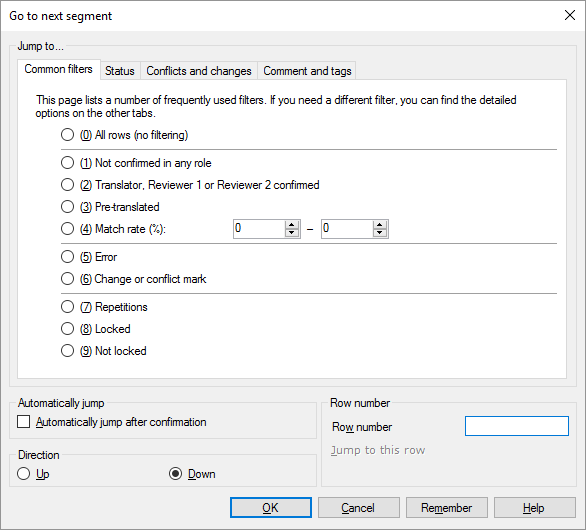
What can you do?
In the Row number box, type the number of the segment you want to jump to. Click OK. Or, press Enter.
You can't repeat this jump by pressing Ctrl+G.
- Under Jump to, click the Common filters tab.
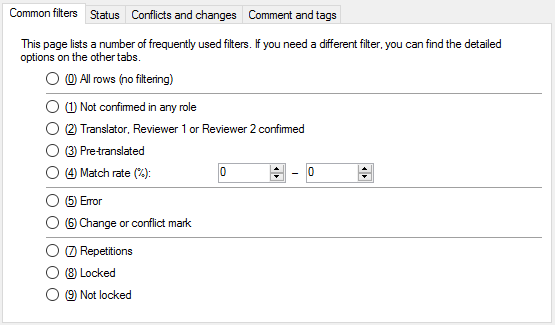
- Click the (1) Not confirmed in any role radio button.
Here are all the options you can choose from:
- All rows (no filtering) radio button: Use this if you are filtering for something else, such as repetitions or text.
- Not confirmed in any role radio button: Gets segments that were not confirmed by a translator or a reviewer. They can be any other status, like Not started or Edited.
- Translator, Reviewer 1 or Reviewer 2 confirmed radio button: Gets segments that are Translator confirmed, Reviewer 1 confirmed, or Reviewer 2 confirmed.
- Pre-translated radio button: Gets segments that were filled in through pre-translation, and were not changed since.
- Match rate radio button: Gets segments that were originally pre-translated or filled in with a certain match rate. (Since then, they may have been edited or confirmed, but the match rate is still there.) Type two numbers in the boxes next to the radio button. For example, if you type 80 to 90, memoQ displays segments with matches between 80 and 90 percent.
- Error radio button: Gets segments that have errors. Errors prevent the document from being exported.
- Change or conflict mark radio button: Gets segments that were changed by someone else, or were modified by multiple users at the same time. These marks appear when several users work on a document in an online project. You can use this in a checkout of an online project.
- Repetitions radio button: Gets segments that are marked as repetitions. This is different from the settings in the Filters by frequency section.
- Non-repetitions radio button: Gets segments that are not marked as repetitions.
- Locked radio button: Gets locked segments.
- Not locked radio button: Gets segments that are not locked.
- Under Jump to, click the Status tab.
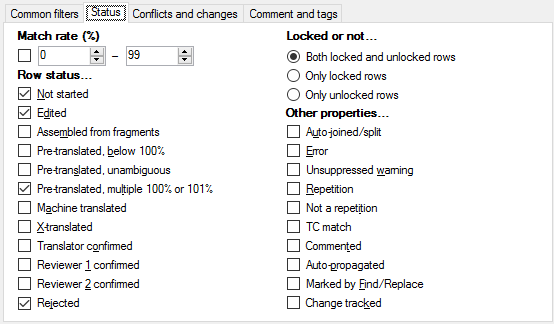
- Check the Edited and the Error check boxes.
Here are all the options you can use:
- Match rate (%): Gets segments that were originally pre-translated or filled in with a certain match rate. (Since then, they may have been edited or confirmed, but the match rate is still there.) Check the check box before the two number boxes. Fill in the number boxes with two numbers. For example, if you enter 80 and 90, memoQ will give you segments that were originally pre-translated or filled in with a match rate between 80 and 90 percent.
- Row status section:
- Not started: Gets empty segments where translation wasn't started.
- Edited: Gets segments that were edited but not confirmed.
- Assembled from fragments: Gets segments that were put together from terms or other partial matches (fragments).
- Single 100% match: Gets segments that are 100% matches and come from pre-translation.
- Single 101% match: Gets segments that are 101% matches and come from pre-translation.
- Multiple 100% or 101% matches: Gets segments that are 100% or 101% matches and come from pre-translation.
- Translator confirmed: Gets confirmed segments.
- Reviewer 1 confirmed: Gets segments that were confirmed by a Reviewer 1.
- Reviewer 2 confirmed: Gets proofread segments.
- Locked or not section:
- Both locked and unlocked rows: Doesn't matter whether a segment is locked or unlocked.
- Only locked rows: Gets the locked segments only. You can't edit locked segments.
- Only unlocked rows: Gets the segments that are not locked.
- Other properties section:
- Auto-joined/split: Gets segments that are the result of joining or splitting segments automatically. memoQ does this during pre-translation.
- Error: Gets segments with errors. Errors prevent documents from being exported.
- Unsuppressed warning: Gets segments with warnings that were not ignored.
- Repetition: Gets segments that are a repetitions of other segments within a document.
- Not a repetition: Gets segments that are not repetitions of other segments within a document.
- Commented: Gets segments that contain comments. The contents of the comments don't matter.
- Auto-propagated: Gets segments that came from auto-propagation.
- Marked by Find/Replace: Gets every segment that was marked as a find or replace hit.
- Change tracked: Gets segments where track changes were used and the original target segment was modified.
If you check two or more check boxes, memoQ gets all segments that match one of them. For example, if you check Not started and Edited, you'll get all Not started and all Edited segments.
If you check two or more check boxes, memoQ gets all segments that match one of them. For example, if you check Error and Unsuppressed warning, you'll get all segments that have either an error or a warning.
If you use a combination of settings from the three groups, they must be matched together. For example, if the settings are the following:
- Only unlocked rows radio button selected, and
- Edited and Translator confirmed check boxes checked, and
- Unsuppressed warning and Commented check boxes checked:
memoQ gets segments that are not locked and are either edited or confirmed, and have an unsuppressed warning or a comment, or both.
You can use this in a checkout of an online project. Or, in a local project where documents were updated from bilingual files.
- Under Jump to, click the Conflicts and changes tab.
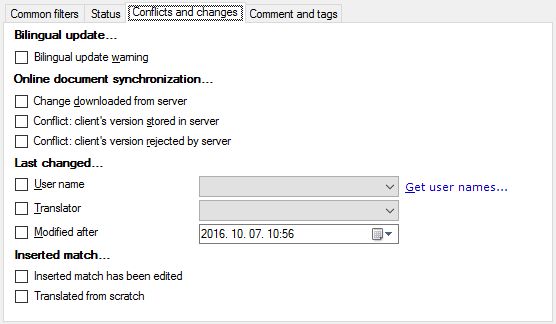
- Check the Change downloaded from server check box.
Here are all the options you can use:
- Bilingual update section:
- Bilingual update warning check box: Gets segments that were modified when the document was updated from a bilingual file.
- Online document synchronization section:
- Change downloaded from server check box: Works in a checkout of an online project. Gets segments that were modified by another user, and were downloaded from the server.
- Conflict: client's version stored in server check box: Works in a checkout of an online project. Gets segments that were in conflict with another change from someone else, and your change was saved to the memoQ server.
- Conflict: client's version rejected by the server check box: Works in a checkout of an online project. Gets segments that were in conflict with another change from someone else, and your change was rejected by the server. This means that the other user's version "won".
- Last changed section:
- User name text box: Type a user name here. Gets segments that were last modified by the user by that name. The name doesn't have to be one from the memoQ server. User names in documents may come from various other places, too.
- Translator text box: Type a user name here. Gets segments that were translated by the user by that name. The name doesn't have to be one from the memoQ server. User names in documents may come from various other places, too.
You can choose from the actual user names that are there in the document: Before you do that, click Get user names.
- Modified after date selector: Select a date and time here. Gets segments that were modified on this date and at this hour, or later.
- Inserted match section:
- Inserted match has been edited: Gets segments where a match was inserted, but the current translation is different from that match.
- Translated from scratch: Gets segments where a match was not inserted.
- Under Jump to, click the Comment and tags tab.

- To find segments with a certain comment: Type an expression in the Comment contains text box.
Here are all the options you can use:
- Comment contains text box: Type an expression here. memoQ gets segments that have at least one comment containing the expression. You can type several expressions, too, separated with a comma (,). memoQ gets segments where one of the expressions is in one of the comments.
- Source has memoQ {tag} check box: Gets segments where the source text includes an uninterpreted formatting tag.
- Target has memoQ {tag} check box: Gets segments where the target text includes an uninterpreted formatting tag.
- Source has inline tag check box and text box: Gets segments where the source text contains inline tags with a specific text. Type the text in the text box next to the check box. You can type several expressions, too, separated with a comma (,). memoQ gets segments where one of the expressions is in one of the inline tags on the source side.
- Target has inline tag check box and text box: Gets segments where the target text contains inline tags with a specific text. Type the text in the text box next to the check box. You can type several expressions, too, separated with a comma (,). memoQ gets segments where one of the expressions is in one of the inline tags on the target side.
When you filter for inline tags, you can also check their attributes. In the expressions you type, you can specify a tag that has an attribute with a specific value. To check an attribute of a tag, type the name of the tag, then a > sign, and then the name of the attribute. If you also want to check the value of the attribute, type one more > sign, and then the value. Here are your options:
- tagname: Finds all tags that have tagname occurring in their names. Example: ingredient will find all of these:
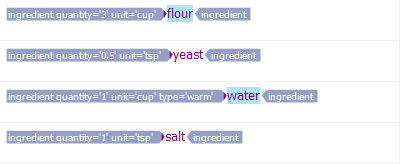
- tagname>attributename: Finds all tags that have a specific attribute, regardless of its value. Example: ingredient>type will find this:

- tagname>attributename>value: Finds all tags that have a specific attribute with a specific value. Example: ingredient>unit>cup will find these two:

- You can omit the name of the tag or the attribute. Thus you can find inline tags where the tag name is different, but they have the same attribute. Or, you can look for inline tags where both the tag name and the attribute name are different, but they share a common value. To find the above two segments, you can type this: >unit>cup, or this: >>cup.
- If the value contains spaces or commas, write them between quotes. Example: >author>name>"Technical Writer".
- Anything you write in the value part without quotes or with double quotes will be found in the text of the value. (In other words: memoQ doesn't check for a full match.) For example, ingredient>unit>c will find this:

- If you want an exact match, write the value between single quotes: ingredient>unit>'cup'.
- To write a double quote inside a value name, type it with a back slash: \". To write a single quote (apostrophe) inside a value name, type it (again) with a back slash: \'.
You can write relatively complex expressions here. memoQ warns you if your input has wrong syntax. The background of the text box turns light red if there is something wrong:


memoQ jumps to segment that meets all conditions: If you select several conditions, maybe even across different tabs, memoQ jumps to the first segment that matches all the conditions. If there is no segment that matches all the conditions, memoQ won't jump.
Speed up reviewing the document. Jump to next whenever you confirm a segment: Under Automatically jump, check the Automatically jump after confirmation check box. When you translate, and click Confirm, Confirm and Overwrite, or Confirm Without Update commands (or press Ctrl+Enter or Ctrl+Shift+r), memoQ jumps to the next segment that meets the conditions.
To jump back: Normally, memoQ jumps forward. But if you suspect that the segment you need is upwards in the document: Under Direction, click the Up radio button.
When you finish
To save the jumping conditions, and jump immediately: Click OK.
To just save the jumping conditions, and not jump: Click Remember.
To just return to the translation editor, and neither save nor jump: Click Cancel.
To jump again with the same conditions: In the translation editor, press Ctrl+G. memoQ uses the last conditions to jump to the next matching row.